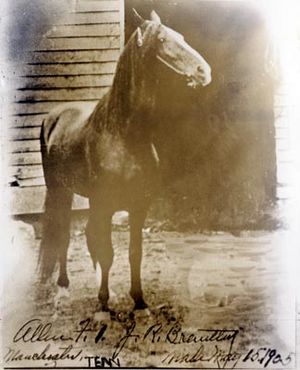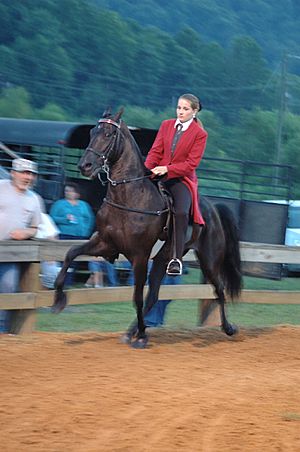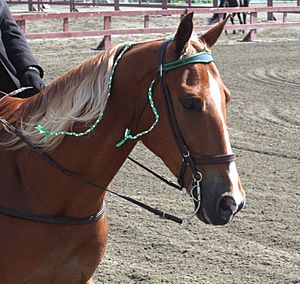Tennessee Walking Horse facts for kids

Flat-shod Tennessee Walking Horse
|
|
| Distinguishing features | Unique running-walk, tall, long neck; calm disposition; long, straight head |
|---|---|
| Alternative names | Tennessee Walker Walking Horse Walker TWH |
| Country of origin | Tennessee, USA |
| Breed standards | |
| Tennessee Walking Horse Breeders' and Exhibitors' Association | Breed standards |
| National Walking Horse Association | Breed standards |
| Horse (Equus ferus caballus) | |
The Tennessee Walking Horse or Tennessee Walker is a breed of gaited horse known for its unique four-beat running-walk and flashy movement. It was originally developed in the southern United States for use on farms and plantations. It is a popular riding horse due to its calm disposition, smooth gaits and sure-footedness. The Tennessee Walking Horse is often seen in the show ring, but is also popular as a pleasure and trail riding horse using both English and Western equipment. Tennessee Walkers are also seen in movies, television shows and other performances.
The breed was developed beginning in the late 18th century when Narragansett Pacers and Canadian Pacers from the eastern United States were crossed with gaited Spanish Mustangs from Texas. Other breeds were later added, and in 1886 a foal named Black Allan was born. He is now considered the foundation sire of the breed. In 1935 the Tennessee Walking Horse Breeders' Association was formed, and it closed the studbook in 1947. In 1939, the first Tennessee Walking Horse National Celebration was held.
In the early 21st century, this annual event has attracted considerable attention and controversy, because of efforts to prevent abuse of horses that was practiced to enhance their performance in the show ring.
The two basic categories of Tennessee Walking Horse show competition are called "flat-shod" and "performance", distinguished by desired leg action. Flat-shod horses, wearing regular horseshoes, exhibit less exaggerated movement. Performance horses are shod with built-up pads or "stacks", along with other weighted action devices, creating the so-called "Big Lick" style. The United States Equestrian Federation and some breed organizations now prohibit the use of stacks and action devices at shows they sanction.
In addition, the Tennessee Walking Horse is the breed most affected by the Horse Protection Act of 1970. It prohibits the practice of soring, abusive practices which can be used to enhance the Big Lick movement prized in the show ring. Despite the law, some horses are still being abused. The controversy over continuing soring practices has led to a split within the breed community, criminal charges against a number of individuals, and the creation of several separate breed organizations.
Breed characteristics
The modern Tennessee Walking Horse is described as "refined and elegant, yet solidly built". It is a tall horse with a long neck. The head is well-defined, with small, well-placed ears. The breed averages 14.3 to 17 hands (59 to 68 inches, 150 to 173 cm) high and 900 to 1,200 pounds (410 to 540 kg). The shoulders and hip are long and sloping, with a short back and strong coupling. The hindquarters are of "moderate thickness and depth", well-muscled, and it is acceptable for the hind legs to be slightly over-angulated, cow-hocked or sickle-hocked.
They are found in all solid colors, and several pinto patterns. Common colors such as bay, black and chestnut are found, as are colors caused by dilution genes such as the dun, champagne, cream and silver dapple genes. Pinto patterns include overo, sabino and tobiano.
The Tennessee Walking Horse has a reputation for having a calm disposition and a naturally smooth riding gait. While the horses are famous for flashy movement, they are popular for trail and pleasure riding as well as show.
The Tennessee Walking Horse is best known for its running-walk. This is a four-beat gait with the same footfall pattern as a regular, or flat, walk, but significantly faster. While a horse performing a flat walk moves at 4 to 8 miles per hour (6.4 to 12.9 kilometres per hour), the running walk allows the same horse to travel at 10 to 20 miles per hour (16 to 32 kilometres per hour). In the running walk, the horse's rear feet overstep the prints of its front feet by 6 to 18 inches (15 to 46 centimetres), with a longer overstep being more prized in the Tennessee Walking Horse breed. While performing the running walk, the horse nods its head in rhythm with its gait. Besides the flat and running walks, the third main gait performed by Tennessee Walking Horses is the canter. Some members of the breed perform other variations of lateral ambling gaits, including the rack, stepping pace, fox trot and single-foot, which are allowable for pleasure riding but penalized in the show ring. A few Tennessee Walking Horses can trot, and have a long, reaching stride.
History

The Tennessee Walker originated from the cross of Narragansett Pacer and Canadian Pacer horses brought from Kentucky to Tennessee starting in 1790, with gaited Spanish Mustangs imported from Texas. These horses were bred on the limestone pastures of Middle Tennessee, and became known as "Tennessee Pacers". Originally used as all-purpose horses on plantations and farms, they were used for riding, pulling and racing. They were known for their smooth gaits and sure-footedness on the rocky Tennessee terrain. Over the years, Morgan, Standardbred, Thoroughbred and American Saddlebred blood was also added to the breed.
In 1886, Black Allan (later known as Allan F-1) was born. By the stallion Allendorf (from the Hambletonian family of Standardbreds) and out of a Morgan mare named Maggie Marshall, he became the foundation sire of the Tennessee Walking Horse breed. A failure as a trotting horse, due to his insistence on pacing, Black Allan was instead used for breeding. From his line, a foal named Roan Allen was born in 1904. Able to perform several ambling gaits, Roan Allen became a successful show horse, and in turn sired several famous Tennessee Walking Horses.
The Tennessee Walking Horse Breeders' Association was formed in 1935. To reflect interest in showing horses, the name was changed in 1974 to the current Tennessee Walking Horse Breeders' and Exhibitors' Association (TWHBEA). The stud book was closed in 1947, meaning that since that date every Tennessee Walker must have both its dam and stud registered in order to be eligible for registration. In 1950, the United States Department of Agriculture recognized the Tennessee Walking Horse as a distinct breed.
In 2000, the Tennessee Walking Horse was named the official state horse of the US state of Tennessee. It is the third most-common breed in Kentucky, behind the Thoroughbred and the American Quarter Horse. As of 2005, 450,000 horses have been registered over the life of the TWHBEA, with annual registrations of 13,000–15,000 new foals. While the Tennessee Walking Horse is most common in the southern and southeastern US, it is found throughout the country.
Uses
The Tennessee Walker is noted for its appearance in horse show events, particularly performances in saddle seat-style English riding equipment, but is also a very popular trail riding horse. Some are used for endurance riding. To promote this use, the TWHBEA maintains an awards program in conjunction with the American Endurance Ride Conference.
In the 20th century, the Tennessee Walking Horse was crossed with Welsh ponies to create the American Walking Pony, a gaited pony breed.
The breed has also been featured in television, movies and other performing events. The Lone Ranger's horse "Silver" was at times played by a Tennessee Walker. "Trigger, Jr.", the successor to the original "Trigger" made famous by Roy Rogers, was played by a Tennessee Walker named Allen's Gold Zephyr. The position of Traveler, mascot of the University of Southern California Trojans, was held at various times by a purebred Tennessee Walking Horse, and by a Tennessee Walker/Arabian cross.
Horse shows
The two basic categories of Tennessee Walking Horse show competition are called "flat-shod" and "performance". Flat-shod horses compete in many different disciplines under both western and English tack. At shows where both divisions are offered, the flat-shod "plantation pleasure" division is judged on brilliance and show presence of the horses while still being well mannered, balanced, and manageable. "Park pleasure" is the most animated of the flat-shod divisions. Flat-shod horses are shown in ordinary horseshoes, and are not allowed to use pads or action devices, though their hooves are sometimes trimmed to a slightly lower angle with more natural toe than seen on stock horse breeds.
Tennessee Walking Horses are typically shown with a long mane and tail. Artificially set tails are seen in "performance" classes, on full-grown horses in halter classes, and in some harness classes, but generally are not allowed in pleasure or flat-shod competition.
Performance horses, sometimes called "padded" or "built up", exhibit flashy and animated gaits, lifting their forelegs high off the ground with each step. This exaggerated action is sometimes called the "Big Lick". The customary style for rider attire and tack is saddle seat. Horses are shod in double and triple-nailed pads, which are sometimes called "stacks". In the early 21st century, this form of shoeing is now prohibited at shows governed by the National Walking Horse Association (NWHA), and the United States Equestrian Federation (USEF). Artificially set tails are seen in "performance" classes, on full-grown horses in halter classes, and in some harness classes, but generally are not allowed in pleasure or flat-shod competition.
Horses in western classes wear equipment similar to that used by other breeds in western pleasure classes, and exhibitors may not mix English and Western-style equipment. Riders must wear a hat or helmet in western classes. Tennessee Walkers are also shown in both pleasure and fine harness driving classes, with grooming similar to the saddle seat horses. In classes where horses are turned out in saddle seat equipment, it is typical for the horse to be shown in a single curb bit with a bit shank under 9.5 inches (24 cm), rather than the double bridle more common to other saddle seat breeds. Riders wear typical saddle seat attire. Hats are not always mandatory, but use of safety helmets is allowed and ranges from strongly encouraged to required in some pleasure division classes.
Show rules and organizations
Controversies over shoeing rules, concerns about soring, and the breed industry's compliance with the Horse Protection Act has resulted in the development of multiple governing organizations. The breed registry is kept by the TWHBEA, which promotes all riding disciplines within the breed, but does not sanction horse shows.
The USEF does not currently recognize or sanction any Tennessee Walking Horse shows. In 2013 it banned the use of action devices and stacks at any time in any class.
The Tennessee Walking Horse Heritage Society is a group dedicated to the preservation of the original Tennessee Walker bloodlines, mainly for use as trail and pleasure horses, rather than for showing. Horses listed by the organization descend from the foundation bloodstock registered by the TWHBEA. Pedigrees may not include horses that have been shown with stacks post-1976.
Two organizations have formed to promote the exhibition of flat-shod horses. The National Walking Horse Association (NWHA) promotes only naturally gaited horses in its sanctioned horse shows, has its own rule book, and is the official USEF affiliate organization for the breed. The NWHA sanctions horse shows and licenses judges, and is an authorized HIO.
The NWHA was in the process of building its own "tracking registry" to document both pedigree and performance achievements of horses recorded there. These included the Spotted Saddle Horse and Racking Horse breeds as well as the Tennessee Walker. However, the NWHA was sued by the Tennessee Walking Horse Breeders & Exhibitors Association (TWHBEA), which eventually won some concessions regarding the use of the TWHBEA’s copyrighted registry certificates by the NWHA. While the judgment did not prohibit the NWHA from continuing its registry service, this is no longer advertised on the NWHA website.
Friends of Sound Horses (FOSH) also promotes exhibition of flat-shod and barefoot horses. It licenses judges for both pleasure classes and gaited dressage, promotes use of gaited horses in distance riding and sport horse activities, and is an authorized HIO.
Two organizations promulgate rules for horse shows in which action devices are allowed: the Walking Horse Owners Association (WHOA) and "S.H.O.W." ("Sound horses, Honest judging, Objective inspections, Winning fairly") which regulates the Tennessee Walking Horse National Celebration. The Celebration has been held in Shelbyville, Tennessee, each August since 1939. It is considered the showcase competition for the breed. In the early 21st century, the Celebration has attracted large amounts of attention and controversy due to the concerns about violations of the Horse Protection Act.
See also
 In Spanish: Caballo Tennessee Walking para niños
In Spanish: Caballo Tennessee Walking para niños






